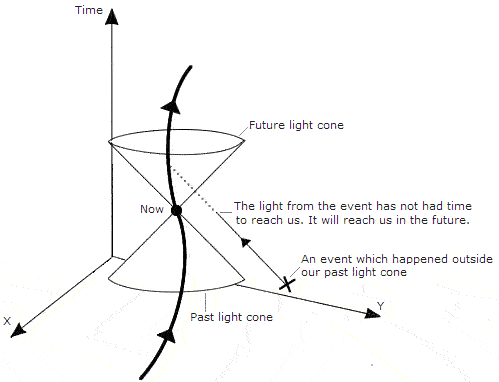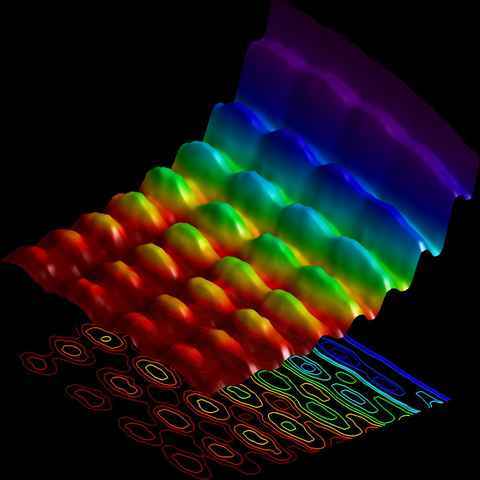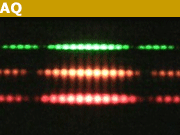Retrocausality: How Fundamental is the Arrow of Time?
In this Insight, I’ll discuss a recent experiment ([1] [2] [3]) by some Australian physicists that has brought a thought experiment into the real world [4], and in doing so has lent some ammunition to a most unlikely idea:
Retrocausality: A reversal of the concept of causality, allowing effects to occur before the events that cause them.
Table of Contents
The Arrow of Time

Figure 1: Events occur at points in spacetime. At each point Q, there is a light
cone consisting of two parts. The future light cone is the three-dimensional
surface generated by the light rays emerging from Q. The past light cone is similarly defined by the light rays converging on Q. (The labels ‘future’ and ‘past’ are conventions at this point in the discussion. In Section IV we will define them in the cosmological context.) Points inside the light cone of Q are timelike separated from it; points outside the light cone are spacelike separated. Points inside the future light cone of Q are in its future; points inside the past light
cone are in its past. Points outside the light cone are neither.
Source: http://arxiv.org/pdf/gr-qc/0403001v2.pdf
“The arrow of time” simply refers to the way that time passes. Most people take the arrow of time for granted because we observe it as having a direction: forward. That’s the way we perceive it, the way we interact with it. Water does not spontaneously jump back into a glass, buildings do not materialize from the rubble, etc… These things all serve to give time a definite sense of direction. When you do things, they have consequences that come afterward. For scientists, the idea that all effects have a preceding cause is referred to as causality.
Causality is a pretty deeply rooted idea. There is an awful lot of evidence that the arrow of time has a single direction. It’s one of the assumptions made in Special Relativity [5], because without causality there is the ability to move faster than light, and an effect can be observed before its cause (see Figure 1). It’s also required by the Second Law of Thermodynamics [6], whereby the perpetual increase of entropy in closed systems requires a single direction for a time. There is even evidence [7] that the arrow of time arises naturally out of a universe that has gravity.
My personal feeling is that the arrow of time is fundamental and shouldn’t be thrown around lightly. Without an absolute arrow of time, we end up with a universe where time travel is possible, but events are mostly deterministic, resulting in free will being only an illusion. Depending on your views of the world, a lack of a free will can be disturbing.
The Experiment
The experimental setup is quite clever, as described in [3]:
“…They fired the atoms at two grate-like forms created by lasers, although the effect was similar to a solid grate.
However, the second grate was only put in place after the atom had passed through the first one. And the second grate wasn’t applied each time, only randomly, to see how the particles reacted differently.
What they found was that, when there were two grates in place, the atom passed through it on many paths in a wave form, but, when the second grate was removed, it behaved like a particle and took only one path through.
So, what form it would take after passing through the first grate depended on whether the second grate was put in place afterward. Therefore, whether it continued as a particle or changed into a wave wasn’t decided until a future event had already taken place.
Time went backwards. Cause and effect appear to be reversed. The future caused the past. The arrow of time seemed to work in reverse.”
This amazing result caused one of the scientists to say, “It proves that measurement is everything. At the quantum level, reality does not exist if you are not looking at it.” Though that seems a bit sensational to me, it really is what’s on the table!
The Strangeness of Wave-Particle Duality

The first-ever photo of light as both a particle and a wave. http://www.eurekalert.org/pub_releases/2015-03/epfd-tfe030115.php
A key sentence in the description of the experiment is this one:
Therefore, whether it continued as a particle or changed into a wave wasn’t decided until a future event had already taken place.
This is key because it says that retrocausality is only implied by the experiment if this choice is occurring! In other words, if you operate under the assumption that the atom “decides” to behave as a particle, or as a wave, depending on the physical situation, then the information involved in making that choice would seem to violate causality.
But why do elementary particles sometimes act like particles, and other times act as waves [8]? Are they just both all the time? For that matter, what does it mean to exist as both? Does the particle exist at all before it is measured? These are all questions that we don’t yet have solid answers to!
It’s timely that this experiment was reported about the same time that the first-ever picture of light as both a wave and a particle was released. This helps bring several conflicts in physics into the public eye, which is a great opportunity for discussion.
Quantum Interpretations
Here are a few interpretations of this experiment:
- Causality is being violated. The atom is choosing how to behave midway through the experiment based on future information about whether the second grate will be added.
- Causality is not being violated. The atom could not have decided to “be a particle” or “be a wave” before the actual measurement was made at the end of the experiment.
- Causality is not being violated. Particles never “decide” to be a particle or a wave, they are always both, all the time. This experiment just displays the inadequacies of measurement.
What do you think? Do you have a different interpretation? Is the arrow of time fundamental, or can it be tampered with?
References and Additional Reading
- Experiment Confirms Quantum Theory Weirdness (anu.edu)
- Experiment Confirms Quantum Theory Weirdness (sciencedaily.com)
- Scientists show future events decide what happens in the past (digitaljournal.com)
- Wheeler’s Delayed Choice Experiment (Wikipedia)
- Special relativity: Causality and the prohibition of motion faster than light (Wikipedia)
- Entropy’s Arrow of Time (Wikipedia)
- How Gravity Explains Why Time Never Runs Backward (wired.com)
- Wave-Particle Duality (Wikipedia)
- The Physics of ‘Now’ James B. Hartle (arxiv.org)
- The first ever photograph of light as a particle and a wave (eurekalert.com)
Josh received a BA in Physics from Clark University in 2009, and an MS in Physics from SUNY Albany in 2012. He currently works as a technical writer for MathWorks, where he writes documentation for MATLAB.








I vote for 2).
Does this experiment violate any Bell inequality?
I can’t find the article, but it seems there is only one particle involved, so it seems unlikely that a Bell inequality is violated. If no Bell inequality is violated, then we are not forced to abandon classical relativistic causality, so it seems that causality should still be intact.
“Time DOES slow down as the speed of light is approached. Where is there any evidence of the opposite?”
Its misleading. Proper time, for example, remains the same. Suppose you have two inertial frames moving close to the speed of light relative to each other. Each has a clock placed at the origin. Each will read the same time on their clocks, but see the other clock as running slower. Which is correct? Which runs slower?
What’s really going on is its like rotating a rod to fit through a door. The rod length remains the same – but its relation to other coordinate systems is different. In fact formally length contraction and time ‘slowing down’ can be viewed as hyperbolic rotation.
But really this issue should be discussed on the relativity sub-forum – not here.
Thanks
Bill
[USER=331]@HallsofIvy[/USER] “(there is, at one point, “particle or atom”, but I presume that is a typo).”
Thanks for pointing out the error, I fixed it.
[USER=559673]@votingmachine[/USER] : Thanks for reading, and welcome to PF! Your interpretation of the time dilation equations of Special Relativity is, as bhobba pointed out, a common misconception. See [URL=’http://www.quora.com/If-a-photon-travels-at-the-speed-of-light-and-time-dilation-at-the-speed-of-light-is-infinite-does-this-mean-that-from-the-photons-perspective-it-takes-no-time-at-all-to-cross-the-entire-universe’]this well written response[/URL] for a good explanation.
[USER=465472]@dayalanand roy[/USER] Thanks for reading, Dayalanand. Let me respond to your questions in order:
1. This experiment is indeed another type of delayed choice experiment. You can read more about it here: [URL]https://en.wikipedia.org/wiki/Wheeler’s_delayed_choice_experiment[/URL]
2. I chose irreversible examples to imply that entropy is always increasing (the second law of thermodynamics). Entropy is one of the only quantities that requires a specific direction for time. Reversible thermodynamic processes are not particularly interesting to this end since they are performed at equilibrium and keep entropy constant. In fact, it is this conservation of entropy that allows them to be time-reversible! If the entropy had increased, the process would be irreversible, hence the arrow of time. Irreversible processes are primarily what occurs in nature.
3. For a full explanation of why entropy implies an arrow of time, read this: [URL]https://en.wikipedia.org/wiki/Entropy_(arrow_of_time)[/URL]
4. On this point we can agree somewhat. I don’t think time travel is in the cards, either.
5. Spacetime is the fusion of three dimensions of space and one dimension of time into a single continuum. I don’t think calling it the “fourth dimension of space” is technically correct. While spacetime was a major leap forward in our understanding of time, note that this experiment was dealing with quantum mechanics instead of relativity, and the two theories are famously incompatible. Our explanations of relativistic time do not account for many of the weird things in QM.
When you get right down to it, I think you’re correct that dimensions do not “exist” in a physical sense. They are descriptions we have applied to nature for the purposes of prediction, and they do a great job at that.
A number of posts in this thread have been removed, as they were driving the discussion off-topic.
I’d like to remind the participants about the Physics Forums rules about personal theories. They are not allowed unless supported by peer-reviewed publications or other scientifically accepted sources – and the books that pump out misleading half-truths like “time slows down as the speed of light is approached” aren’t that).
“No time elapses at the speed of light.”
That’s a common misconception.
SR is the theory about transformations between inertial frames. No inertial frame can travel at the speed of light so the theory says nothing about time at the speed of light.
Even plugging c into the equations you end up with the dreaded 1/0 which is undefined.
Thanks
Bill
“I have no doubt it’s someplace at every instant, just we cant measure where..”
As I said, that’s the problem that’s particularly hard to shake.
Once you do, progress is swift in understanding QM.
Thanks
Bill
I haven’t seen an analysis of the experiment mentioned in the paper, but it looks like a variation of the good old delayed choice experiment. Before going any further I think a careful analysis of that experiment needs to be part of the debate:
[URL]http://quantum.phys.cmu.edu/CQT/chaps/cqt20.pdf[/URL]
Like a lot of things in QM where people talk about sometimes its a particle and sometimes its a wave, the reality when you look at it carefully, is its got nothing to do with that outmoded idea. Its never really a paticle or a wave – its always just quantum stuff. Whats quantum stuff:
[URL]http://www.scottaaronson.com/democritus/lec9.html[/URL]
QM IMHO, as I have posted many times, is simply the most reasonable probability model that allows continuous transformations between pure states. The real interpretive issue is not the formalism – we understand it and why its like that pretty well – it’s a model of observations – observations are the primitive of the theory. This is what causes all the angst and worry. Everyday experience is the world is more than just observation. You see it all the time in discussions about QM – the deep need we seem to have that there is something behind those observations. I believe if you simply accept this one fact much fog and angst about it disappears.
What’s going on with these delayed choice type experiments – IMHO its in simple cases decoherence can be unscrambled, as has been discussed a number of times here on physics forums.
Thanks
Bill
“Does the particle exist at all before it is measured?”
— Just like in a 2D Pokemon video game I used to play.
When you get to a certain point on the map, you can see Nurse Joy looking at you from the hospital’s window.
Was Nurse Joy already at the window earlier? How could you tell?
There is no way to tell while playing the game, as the window is only visible when you get there.
Does the window even exist before you get there?
Does Nurse Joy even exist before you can see her?
who are you sir? i mean if u r not a physicist what are u??
I just want to respond to say how much I love this kind of writing. The weirdness physicists encounter is a huge part of why I love this forum, even though I'm not a physicist. Its just amazing to read about. My impression (as a computer guy) is that the universe is explicable because the universe is in a sense, compressible. For instance, you could accumulate gigabytes of data on the locations on the path of a planet, or you could generate that same data from the comparatively small amount of math which predicts the path of that planet. In fact, because its compressible, if a physicist has enough information about a planet at one moment of time, she can expand the whole path, past and future, out of it. In this sense it collapses the path down from a set of previous possibilities. The reason this is possible is that the system is describable using less information that the universe actually manifests. Its compressible, thus is explicable. If it were not compressible, no point in the future or past would be predictable from any other point, just as an incompressible string is completely random.I haven't read the experiments linked to, but I've read about retro-causality in delayed choice quantum erasure, where the choice a photon makes down the road dictates whether the interference pattern will be observed earlier. You can choose to view that in terms of the choice retro-causing the pattern, or the pattern predetermining the choice, or you can see in terms of compressibility: The which-path information for the whole system, spread out over space and time, is described by only 1 bit, the seemingly spread out nature of it in space and time is the illusion, just as the planet is described by more simple equations. The actual reality is the underlying compressed form. Anyway, that's my two cents on making any sense of it. Thanks again for sharing!
Dear colleaguesOne more comment. It has been said that entropy is the process that requires 'arrow of time'. However, this requirement leads to many unanswerable qestions about time as it gives a sense of 'time as an entity' and then leads some people to say that time does not exist.In my view, it is more sensible to say that it is the entropy and the second law of thermodynamics and the irreversible processes that give us the feeling of the so called 'time's arrow'.Thanks and regards
Highly grateful having such an illuminating reply.Being a non-physicist, it is hard for me to conceptualize about the said QM experiment, but I have tried many a times. After reading the explanations given by Stephen Hawking in his 'the Grand Design', I tried to understand it in following way- Suppose we fire a bullet from a gun. While leaving the gun, the bullet will affect the gun ( as a jerk in the opposite direction)- a causality, but after leaving it, we may not think that it will again affect the gun (no retrocausality). But let us suppose that the bullet is tied with an almost invisible long thread the other end of which is tied with the gun, then some time after leaving the gun, when the bullet travels the length of the thread, the bullet will again affect the gun that may appear to us as a retrocausality.I know that this situation does not simulate with the double slit experiment, but I have just tried to transform the bullet (a particle like thing) -by tying it with a thread- into a wave like thing and see the effect. The explanations of the results of double slit experiment also depend somewhat on the wave- particle duality. Apologies in advance, if my way of thinking is too wild.RegardsDayalanand
@Krell. Thanks. I read the link. I still think that it says what I said. Specifically it says:"there is no meaningful way to discuss how anything looks "from a photon's perspective" in special (or, for that matter, general) relativity. What we can say is that the spacetime distance* of the path travelled by a photon (through vacuum) is zero, but that the actual distance (and hence amount of time) the photon travels depends on the frame of reference."I agree. There is no meaningful way to speak of the time flow. We can say that the "spacetime distance" of a photon path is zero.It is a common conception to speak of the "time flow" rather than the "spacetime distance". I still see nothing wrong with phrasing it in terms of the time flow of the photon although I agree with the formal "spacetime distance=zero". I am not sure why it is a "mis"conception. But if we were to consider the "frame of reference" of the photon, it has a path that has a spacetime distance of zero. Which implies that it does not have any spacetime distance between filter 1 and filter 2. That before and after that we talk of, which create a causality issue, are not a before and after, in that unusual "frame of reference". Two simultaneous things may of course influence each other. I'm not able to dismiss causality. It is embedded too deeply in EVERY model I see. If we get to a result that says time went backwards and causality was reversed, with a later event causing a prior event, then I think it is only reasonable to speculate on explanations that change our interpretation to return to causality.
I am puzzled by the removal of posts. I posted something speculative, and said it was speculative. But it is not CONTRADICTED by current literature. It is not supported or contradicted … it was speculation. I hardly see the point of a comment board that only allows comments that have already been substantiated in the literature. To remove retrocausality I see two possible explanations:The path thru the first grate is not limited, but is actually both allowed paths. That is fairly standard. The second filter then collapses the possibility to the allowed path, acting as observation, even though the "detection" of that collapse happens at a later time. That allows for a causality in an ordinary forward flow of time. The path thru the prior filter was not "caused", but chosen. I believe that is the most accepted interpretation, although it puts the second filter into an observer sort of role.The other is to eliminate the time between the events, and postulate a frame of reference where the two filters are crossed at the same time. That removes retrocausality because there was no before and after. We have no evidence that a frame of reference exists with no time flow. "So, what form it would take after passing through the first grate depended on whether the second grate was put in place afterward. Therefore, whether it continued as a particle or changed into a wave wasn’t decided until a future event had already taken place.Time went backwards. Cause and effect appear to be reversed. The future caused the past. The arrow of time seemed to work in reverse.”"You can get around the objection by saying:the future "CHOSE" the past. Then it isn't causality, but observation and collapse of possibilities.there is no time between the events. They are simultaneous, and therefore there is no "past" between the two. The first is probably correct. I still think the second needs to be considered.Or there is no time flow and causality as we expect them.
Time DOES slow down as the speed of light is approached.Where is there any evidence of the opposite?
Over the years, I have built up a certain mental picture of QM that works for me, and it doesn't seem to conflict with anything that I meet in my ongoing readings. I thought I'd share this as my comment…"Every part of a wave talks to every other part in real time. When one part of the wave reaches a detector, it negotiates with all the other parts. It may, for example, choose to materialize an electron at that place, or it may trip a photo-detector or whatever. All the other parts of the wave "concede" or "agree" to do their further actions in a way that is consistent with this event. The past trajectories and interactions with beam splitters and so on, are already factored into the wave's present configuration, but no decision was taken during transit."To this picture I keep in mind a mental proviso: when you have many particles, they live in Hilbert space; and probabilities apply to the entire measured configuration; but the general idea is like the above.
Dear Josh MeyerI am not a physicist, so you can consider my views as the views of a common man about time (I beg kind permission from the authorities to participate).1. The experiment is almost like the Buckyball or Feyman's experiment, or the delayed choice experiment. The results of these experiments have been nicely interpreted by Stephen Hawking in his 'the grand design' in 'alternative histories' chapter.2. "Water does not spontaneously jump back into a glass, buildings do not materialize from rubbles"I think these things have nothing to do with the arrow of time. They occur simply due to 'things happen the way they can or the way they are allowed to happen by the laws of thermodynamics. To demonstrate time's arrow, people have been deliberately choosing the irreversible events. But there are reversible events as well- ice melts into water and water can freeze back into ice at suitable temperatures. Does it show reversible time's arrows?3. "It is also required by the second law of thermodynamics whereby perpetual increase of entropy in closed system requires a single direction of time"So, if we consider entire universe as a system, where a subsystem, like the life itself, grows by decreasing its entropy, though at the cost of increasing the entropy of the whole system, then should we think that this particular subsystem is going against the time's arrow (though the whole system is going towards time's arrow). This is an unacceptable picture.4." Without an absolute arrow of time, we end up with a universe where time travel is possible"In my view, every moment of the present universe is created with the rubbles of the past and every moment of future will be created with rubbles of present, so we can travel neither to past- it has been consumed to create the present, nor to future- it is yet to be created with rubbles of present. Thus time travel is simply a redundant idea.5. Minkowski and Einstein have at least partly solved the problem of time. They defined it as a dimension- the fourth dimension of space (though I personally believe that this definition too needs a little change in its language). I think a dimension has no independent existence. It is simply a property of the object (here space). The height of a boy (his first dimension) has no existence independent of the boy. The height of the boy does not grow. It is the boy who grows and adds to his height. Similarly, it is the universe and its components that evolve and add to their fourth dimension- time.Thus, the flow of time and time's arrow are, I think, redundant ideas.If my views seem to be non-scientific, I apologise.Thanks and Regards Dayalanand
My main point was that the experiment is interpreted in terms of the particle passage from point A to point B, when the experiment suggests it did not follow that path, for if it did go from source=>slit 1=>optional double slit=>detector, then the insertion of the second option, requires that it have the ability to choose the slit 1 behavior retroactively. Either causality has to go, or the path from A=>B with a time sequence has to go. I would rather find an explanation that leaves causality. That does not mean I am right in wishing the universe has certain properties, just that I would rather find an alternate path for the energy, that allows for it to move from A to B, without the same time sequence as we have, but allowing causality. I suggested that the speed of energy flow being at light speed allowed for a redefinition of the intervening space and time. I still think that the non-existent time flow of a photon is likely zero. And the intervening spatial distance has to be zero in some sense as well, to allow us at least the mathematical out of later having a 0/0 term that we can resolve into the speed of light. These experiments always bother everyone who wants to retain causality. If I grasp at straws, I understand that I am grasping at straws. But I think the straws don't collapse under the criticism that light-speed time-flow is indeterminate.
Everything I've read says time slows down as the speed of light is approached. Nothing says it is stopped at the speed of light. It is true that time flow is infinitely slow as one gets infinitely close to the speed of light. And as arbitrarily slow as anyone might specify, by approaching an speed even closer to light. Whenever I have studied limits in math, we use that definition as defining what happens at the limit. Even though the limit is an indeterminate math quantity, calculus depends on those definition of limits. I will hold that the limit of x/x is 1 even for the indeterminate 0/0. Simply because I hold that as the most sensible bit of math. I think we are not disagreeing all that much. Time slows as light speed is approached. Time is undefined at the limit, when light speed is reached, as in a photon. It is a common conception that time flow is zero at that limit. Or a common misconception. What I object to is you saying it is a misconception. You don't have any evidence or theory that supports that assertion. It is your own conception. Mine is that time flow is zero. Yours is that you don't know., but I'M WRONG. I have to say that I support a statement that you don't know, and I don't know. But I don't support a statement that I am wrong, if I guess one way or the other. It is simply an unsupported guess, which I freely admit. That is a different thing than an incorrect guess. Math says that division by zero is meaningless in math. But the presence of an undefined term in a math model does not necessarily require that the underlying reality is equally indeterminate. As I point out with: x/x when x=0. Do you honestly hold that at that value, when it is 0/0, which is by every method know indeterminate, that x/x is not 1? What about 2x/x, which is equal to 2 everywhere but at 0, where it is 0/0, agains indeterminate? What about (x^2)/x which is equal to x at every point but at 0, where it is 0/0 and indeterminate? We work around division by zero in math all the time. Sometimes we can't and sometimes we can. I'm not opposed to saying that I can't know the time flow at the speed of light. But I am opposed to you saying you also can't know, but I must be wrong.
Of course 1/0 is undefined. But every thing implies that at the limit, the speed of light, there is not any time flow. The limit of 1/n as n=>0 is an infinitely large number, in this case an infinitely slow time flow. We can only guess that AT the limit, there is no time flow. I don't think that is a misconception though. It seems to follow from ordinary reasoning. Nothing with INERTIA can travel at the speed of light, much less inertial frames. Fortunately a photon is massless and inertia-less, so it goes ahead and does it. What I am getting at was actually also suggested in the first link. To quote:"The atoms did not travel from A to B. It was only when they were measured at the end of the journey that their wave-like or particle-like behavior was brought into existence," We surmise that we are putting things in the path, into the space between A and B. But are we in fact doing that? I think they are hinting that the results say no.I rather think I like the idea that the photon has no path. It can go anywhere. It could be emitted at the beginning of the big bang, and travel in a convoluted path to be detected today (cosmic background), or the infinite future. And that path really is not a path from A to B, but a direct connection of A and B, with time removed. When we insert time, we obtain an artifactual result about the path. I'm still at the half-baked description, but I don't think there is a real objection to stating the photon has no time flow. Our math may not allow a valid solution to knowing the time flow at the speed of light (the photon's speed), but that does not mean it does not exist. Mine may be a common misconception, or it may be a common understanding that is conceptually correct. You haven't really identified a problem so much as identified a point of the unknown. Which I happily grant, as pretty much everything I said was a half-baked stab at the unknown. Sorry to sound snarky (my typing always reads as much more snarky than I actually am). But I don't accept a criticism that says, well current theory says nothing about the time flow at the speed of light, so stipulating it as zero is not yet supported. Of course. Current theory also cannot explain the path of the photon from point A to point B in these experiments either.
This is again the "is matter a particle or a wave" argument (there is, at one point, "particle or atom", but I presume that is a typo). I think that the very concepts of "particle" and "wave" are "macro" concepts and do not apply to the micro world of quantum processes.
I'm new on this site and will have to look at the article later. But I have often wondered if the problem is not with the arrow of time but with the dilation of time. We model it that a photon of light leaves a source and travels thru space and arrives at a target. And to us, that seems reasonable. But from the point of view of the photon there is another story. No time elapses at the speed of light. The photon has no time, and consequently no spatial transition. The source and target experience a resonance transfer of energy, across no distance. Somehow we have to resolve the problem of why the source and target have no time or distance separation in one sense, and a different separation in our perspective. And obviously, we keep measuring a velocity for the photons thru our space, and finding a result …Perhaps we need a model with higher spatial dimensions that do not have a time axis. So while we talk of the sequential order of events: photon emission, first slit, second slit (or not), and target (with location detected by us) … the photon merely is a representation of energy transfer across a higher dimension connection, that does not have that same time sequence. That is all very half-baked, and I apologize. I spend a little time now and then thinking about the EPR position that there is an underlying reality that is incompletely described in quantum theories. I tend to agree with the side that says the theories are incomplete, and that we just have yet to elucidate a more complete model, that will then leave out the possibility that the photon is making mid-flight decisions on what it is. I am first time reader on this site and will be looking for any threads on EPR and Bell's Inequality … any pointers on good threads to read for insights? If there is an etiquette issue on this site for commenting at the half-baked level prior to looking at the source material … apologies in advance. I'll pick up on the rules later also.
I'm with Jim, except for the "not smart enough" part. Everyone is smart enough by their own means and ends.QM just exposes a fraction of existence which lies between the layers of the onion. You can slice through the layers but not between them.
No way am i smart enough.It is however reminiscent of Isaac Asimov'e papers on Thiotimolinehttp://danm.ucsc.edu/~phoenix/danm203/thiotimoline.pdfWhat about Heisenberg's Indeterminacy principle ? Are their measurements of when and where this photon is within that uncertainty ?I have no doubt it's someplace at every instant, just we cant measure where..